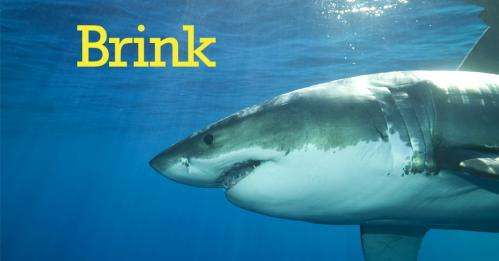Scientists circle the Great White

It is hard to think of a creature more maligned in popular culture than the Great White shark. It rarely comes in contact with humans but is often described as a man-eater and every child knows to hum the "shark" theme from Steven Spielberg's Jaws to signal approaching danger.
But sharks need protecting. Living at the top of the food chain, they play a key role in the ocean's ecology. There are many documented cases about how entire ecosystems are changed when an apex predator is eliminated or drastically reduced in number.
Little is known about Great Whites. We don't know where they are born or the length of their reproductive life. Their lifespan and movements are not well known.
What is clear, though, is shark numbers worldwide are at risk.
Over the past year, UTS Professor William Gladstone has been surveying one of the two known Great White shark nurseries on Australia's east coast, in an area that extends from Newcastle to Seal Rocks.
The Hunter-Central Rivers Catchment Management Authority (CMA) has funded aerial surveys and a tagging program in the nursery area with investment from the Australian Government's Caring For Our Country and the NSW Government's Catchment Action NSW. This most recent work is adding to a long-term CSIRO research program and has benefited from a collaborative partnership between CSIRO, UTS, CMA and the Department of Primary Industries - Fisheries.
The UTS scientist hopes his work will fill some of the gaping holes in our knowledge about this elusive predator and provide a better idea of just how many Great Whites there are, and whether their protected status as a threatened species is effective.
He experiences wonder, not fear when he sees a shark and wishes more people could share his sense of awe. He certainly knows both sides of the story.
"I have been attacked three times while I have been diving. I haven't been bitten but I have been charged," he says.
The attacks, by grey reef sharks and a silver tipped shark, happened when Professor Gladstone was conducting research on the Great Barrier Reef. When the sharks charged, "I lifted my foot up and kicked them on the snout. And they just swam a few circles and swam off", he says.
In nurseries like the one on the NSW mid-north coast, young sharks can be found ranging from newborns about 1.6 metres long to 2.2-metre-long two-year olds. It is a rare time for these loners to congregate.
"There is very little contact between sharks and humans in the nursery area but it is one of the places where the sharks can be observed by scientists," explains Professor Gladstone, who is working with CSIRO shark expert Barry Bruce.
Bruce identified the nursery and is tagging sharks and monitoring their movements.
Thanks to their helicopter surveys, the two scientists have discovered that juvenile Great Whites seem to prefer swimming in the surf zone, where the waves are breaking. They can linger very close to shore and can be found there in reasonably large numbers.
"We've seen them in the very shallow water, about a metre deep, where the waves are breaking," says Professor Gladstone.
He and his research team log the position of every Great White sighted, they estimate the length of each shark, and note their behaviour and whether they are associated with any schools of fish. Female Great Whites don't breed until they are about 14 years old, and then breed only every three years. Professor Gladstone says this makes them vulnerable to threats such as accidental or illegal capture.
Great White sharks have been listed as a vulnerable species. Professor Gladstone says if the protected status is working we would expect there would be more females living long enough to reproduce and "therefore you would have more young being born, and the first place we would get an idea about that is when they arrive in the juvenile nursery areas".
What isn't clear is why these sharks gather in nursery areas, although the presence of schools of Australian salmon could be one reason. Swimming with other juvenile Great Whites might also provide protection from predators such as bigger sharks.
One thing Professor Gladstone knows for sure: the risk to humans from a shark attack is very small. According to Taronga Zoo's Australian Shark Attack File, in the past 50 years there has been an average of one fatal unprovoked attack a year. In contrast, an average of 287 people drowned each year over the past five years.
Provided by University of Technology, Sydney

















